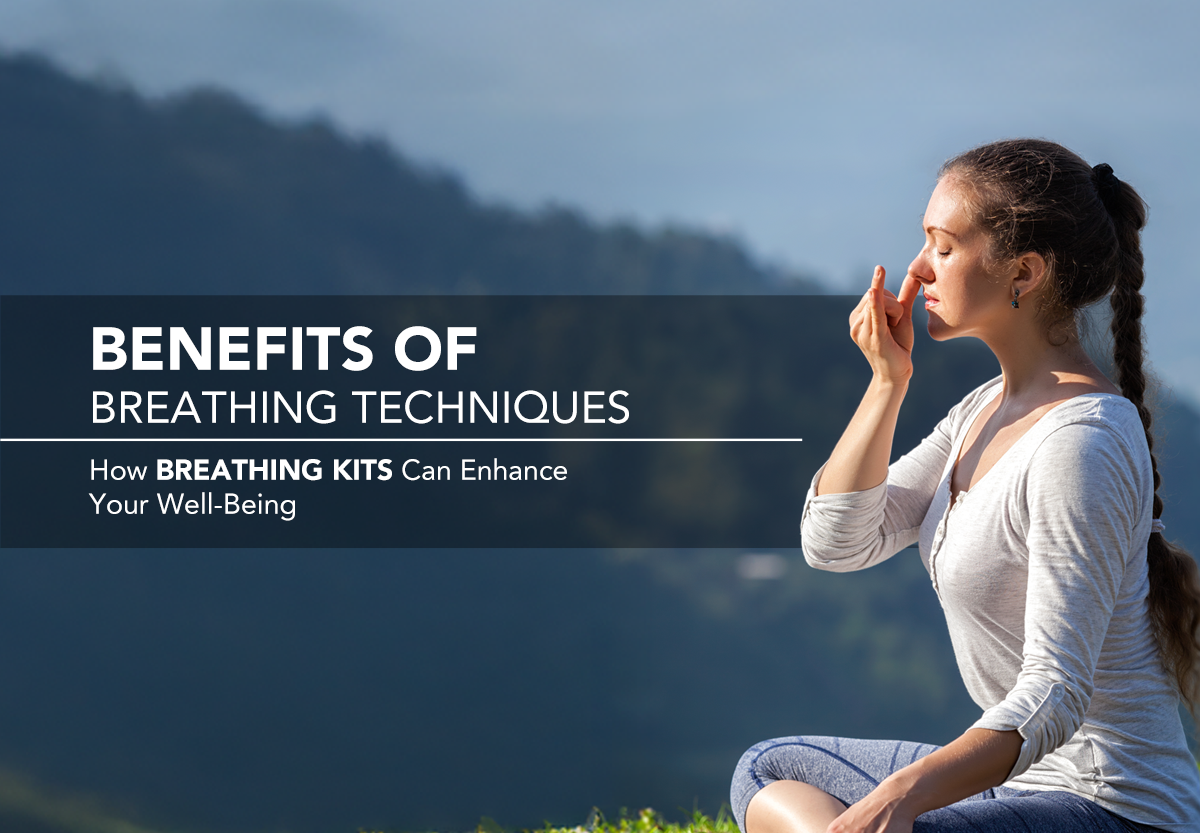
Explore the Benefits of Breathing Techniques and How Breathing Kits Can Enhance Your Well-Being
Breathing is an essential biological function that supports life. It's something we do unconsciously, yet when we focus on it, it can have profound effects on our health and well-being.
In today’s fast-paced world, stress and respiratory concerns are more common than ever. One of the simplest ways to improve mental and physical well-being is through conscious breathing
From reducing anxiety to enhancing lung function, the benefits of conscious breathing are vast. In this article, we will explore breathing techniques, discuss how a breathing kit can improve respiratory health, and explain how to incorporate these practices into your daily life.
Why Breathing Matters
Breathing, although automatic, has a profound impact on both our mental and physical health. Proper breathing techniques can help regulate the nervous system, boost oxygen flow to the brain, and improve lung capacity. As stress and anxiety levels increase in our modern world, conscious breathing offers a natural and effective way to manage these concerns.
Global Statistics and Insights on Breathing Disorders:
|
Breathing Problem |
Global Prevalence (%) |
Source |
|
Asthma |
4.3 |
|
|
COPD (Chronic Obstructive Pulmonary Disease) |
3.9 |
|
|
Sleep Apnea |
1.5 |
|
|
Chronic Bronchitis |
0.5 |
|
|
Allergies/Respiratory Infections |
10 |
American Lung Association |
|
Anxiety-related Breathing Issues |
18 |
Breathing exercises have long been used as a tool for promoting relaxation, mental clarity, and physical health. These exercises can range from simple deep breathing exercises for stress relief to more complex breathing techniques that help improve lung capacity and endurance.
Breathing Exercises and Relaxation Techniques
Incorporating breathing exercises into your daily routine can provide both physical and mental health benefits. These exercises help to relax the body, reduce stress, and increase lung capacity. In addition to the aforementioned breathing techniques for anxiety, there are other methods that promote relaxation and overall wellness:
- Progressive Muscle Relaxation (PMR): This technique involves tightening and relaxing muscle groups while focusing on the breath. It is particularly effective in reducing tension and promoting deep relaxation.
- Breathing Resistance Training: This involves using devices like the incentive spirometer to create resistance while exhaling, which strengthens the lungs and helps improve respiratory endurance. This form of spirometer exercise can be especially useful for athletes and individuals who are recovering from respiratory illnesses.
- Breathing Meditation: Breathing meditation is a form of mindfulness that focuses on deep, rhythmic breathing. By clearing the mind and focusing solely on the breath, you can reduce anxiety, promote relaxation, and improve mental clarity.
- Relaxation Techniques: Incorporating relaxation techniques, such as guided breathing or progressive muscle relaxation, can further enhance the effectiveness of breathing exercises and provide an added layer of stress relief.
Breathing Techniques for Anxiety
One of the most common uses of breathing exercises is to alleviate anxiety. Breathing techniques for anxiety can be a powerful tool for managing stress and calming the nervous system. The act of focusing on the breath helps divert attention from anxious thoughts and triggers, promoting a sense of calm and clarity.
Some popular breathing techniques for anxiety include:
- Diaphragmatic Breathing (Abdominal Breathing): This technique involves breathing deeply into the diaphragm, allowing the abdomen to expand as you inhale. This type of deep breathing is known to activate the parasympathetic nervous system, which is responsible for the "rest and digest" response. It helps reduce the stress response, calming the body and mind.
- 4-7-8 Breathing: This breathing exercise for lungs involves inhaling for 4 seconds, holding the breath for 7 seconds, and exhaling for 8 seconds. This technique is effective in promoting relaxation and improving sleep, as it slows down the heart rate and promotes calmness.
- Box Breathing (Square Breathing): Box breathing involves inhaling, holding, exhaling, and holding the breath again, each for a count of 4. It is a simple yet effective breathing meditation technique that helps regulate the breath, reduce anxiety, and restore focus.
The Role of Breathing Kits
While breathing exercises are effective on their own, certain devices, such as breathing kits, can further enhance these techniques. These kits are designed to support respiratory health, improve lung function, and aid in managing conditions like asthma, chronic obstructive pulmonary disease (COPD), and even anxiety.
A breathing kit typically contains devices like spirometers, nebulizers, peak flow meters, and even portable oxygen concentrators. These tools help individuals monitor and manage their breathing more effectively, ensuring that the body gets enough oxygen and can expel carbon dioxide efficiently.
Tools for respiratory health
1. Spirometer: This device measures lung capacity and airflow. It is used to track how well your lungs are functioning and can help detect early signs of respiratory issues. A spirometer exercise helps you focus on expanding lung capacity and improving respiratory endurance, which is especially useful for athletes or anyone recovering from respiratory illness.
2. Incentive Spirometer: This tool is specifically designed to encourage deep breathing. Using an inspiratory spirometer can help individuals strengthen the diaphragm and improve lung function, which is especially important for people who have undergone surgery or are recovering from respiratory conditions like asthma or pneumonia. Incentive spirometer exercises help improve lung expansion, reduce the risk of lung collapse, and promote better oxygenation.
3. Peak Flow Meter: This handheld device measures how fast a person can exhale. It is particularly helpful for individuals with asthma or other respiratory conditions, allowing them to track their lung function and determine when their symptoms are worsening. Peak flow meter exercises are used to monitor the effectiveness of breathing exercises and adjust treatment plans accordingly.
4. Nebulizer: A nebulizer turns liquid medication into a fine mist that can be inhaled directly into the lungs. This is often used for individuals with asthma or other respiratory conditions to deliver medication in a more efficient and controlled manner. It helps to manage flare-ups and ensure that the airways remain clear.
How to Use a Breathing Kit Effectively
A breathing kit can be used in combination with various breathing exercises to improve lung function and respiratory health. Here’s how you can use it to enhance your practice:
- Morning Routine: Start your day with a few minutes of deep breathing exercises. Using a spirometer or incentive spirometer can help you engage your lungs and boost your energy levels for the day ahead.
- During Work Breaks: Take short breaks throughout the day to practice breathing exercises for anxiety. A few minutes of focused breathing can help you regain focus and reduce stress levels.
- Evening Relaxation: End your day with breathing meditation or a calming technique, such as 4-7-8 breathing, to prepare your body for sleep. You can use your breathing kit during this time to strengthen your lungs and ensure you're practicing proper breath control.
Take a Deep Breath and Begin Your Journey
Unlock the benefits of mindful breathing and embrace a healthier, more balanced lifestyle. Try AIWO’s Breathe Easy Kit today and begin your transformation
What’s Inside the AIWO Breathing Kit?
- Flexible Breathing Tube – Provides resistance and airflow control.
- Mouthpiece – Ensures a comfortable and airtight seal for breathing exercises.
- Inner Chamber (Intermediate Cup) – Directs airflow through water resistance.
- Outer Water Chamber (Base Container) – Holds water to create the necessary resistance for breath training.
- Lid/Connector – Holds the breathing tube securely in place.
How to Use the Aiwo Breathe Easy Kit
- Sit in an upright, comfortable position.
-
Hold the Aiwo Breathe Easy Kit at mouth level, keeping the water chamber upright.
- Inhale deeply through your nose.
- Exhale slowly and steadily through the mouthpiece.
- As you exhale, bubbles will form in the water. This resistance strengthens your lungs.
- Continue for 10-15 breaths per session to enhance lung capacity.
Cleaning & Maintenance
- Rinse the inner and outer chambers with warm water after each use.
- Clean the breathing tube and mouthpiece with mild soap and let them air dry.
- To prevent damage to the plastic components, refrain from using hot water.
- Store the device in a clean, dry place.
Before we conclude, let's take a look at what our customers have to say about the AIWO Breathe Easy Kit:
· Testimonial 1:
"I’ve struggled with anxiety for years, and using AIWO’s Breathe Easy Kit has been a game-changer for me. The simple breathing exercises, combined with the kit’s tools, have not only helped me manage my anxiety but have also improved my lung capacity. I feel more relaxed, focused, and in control of my breath. It's been an essential part of my daily routine."
– Sarah M., Marketing Manger
· Testimonial 2:
"The AIWO Breathe Easy Kit helped me regain control over my breathing after recovering from a respiratory illness. It’s easy to use, and the results have been incredible. My lung capacity has improved significantly, and I feel more energized. I highly recommend this kit to anyone looking to improve their respiratory health."
– James T., Fitness Coach
Our customers' experiences with the Breathe Easy Kit are a testament to its effectiveness in promoting better health through conscious breathing.
Conclusion
Incorporating breathing exercises and a breathing kit into your daily routine can transform your physical and mental well-being. Whether you're practicing breathing techniques for anxiety, engaging in breathing exercises for lungs, or using a spirometer to monitor your lung function, these tools help enhance your health in a variety of ways. Breathing is a simple yet powerful tool for managing stress, improving lung capacity, and achieving overall relaxation. With the help of breathing kits and guided exercises, you can take control of your respiratory health and live a more mindful, healthy life.
References:
1) Breath Tools: A Synthesis of Evidence-Based Breathing Strategies to Enhance Human Running
https://pmc.ncbi.nlm.nih.gov/articles/PMC8967998/
2) Breathing techniques a 'powerful aid to healing'
https://www.bbc.com/news/articles/cx2q5kew93jo
3) Designing, Prototyping and Evaluating Digital Mindfulness Applications: A Case Study of Mindful Breathing for Stress Reduction
https://www.jmir.org/2017/6/e197/
4) Effect of Inspiratory Muscle Training by Using Breather Device in Participants with Chronic Obstructive Pulmonary Disease (COPD)
https://www.ijhsr.org/IJHSR_Vol.9_Issue.4_April2019/12.pdf
5) Conversion of self-contained breathing apparatus mask to open source powered air-purifying particulate respirator for fire fighter COVID-19 response
https://www.sciencedirect.com/science/article/pii/S2468067220300389
